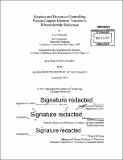Kinetics and dynamics controlling proton-coupled electron transfer in ribonucleotide reductase
Author(s)
Olshansky, Lisa
DownloadFull printable version (37.79Mb)
Other Contributors
Massachusetts Institute of Technology. Department of Chemistry.
Terms of use
Metadata
Show full item recordAbstract
Proton-coupled electron transfer (PCET) reactions comprise a fundamental mechanism for energy transduction in nature. In catalyzing the conversion of ribonucleotides to deoxyribonucleotides, ribonucleotide reductase (RNR) performs reversible, long-range PCET over a pathway of redox active amino acids ([beta]-Y₁₂₂ >/< [beta]-Y₃₅₆ >/< [alpha]-Y₇₃₁ >/< [alpha]-Y₇₃₀ >/< [alpha]-C₄₃₉) that spans ~35 Å and two subunits. As such, RNR serves as a paradigm for the study of PCET in biology. Subunit interaction dynamics, examined by fluorescence spectroscopy, exposed mechanisms underlying allosteric control over PCET and contributed to an expanded kinetic model for turnover. Trapped meta-stable states of the active [alpha]₂[beta]₂ complex are dictated by the translocation of a single charge and attenuate dissociation 10⁴-fold. These trapped states were leveraged to resolve the stoichiometric distribution of the Y¹²²* cofactor from its ensemble average of 1.2 Y*/[beta]₂ , revealing that [beta]₂ contain either 2 or 0 Y*. Circumventing rate-limiting conformational changes that gate turnover, photoinitiated RNRs were prepared to allow photochemically driven Y₃₅₆ oxidation, and spectroscopic resolution of the ensuing reactivity. A series of photoRNRs containing unnatural FnYs (n = 2-3) and W in place of [beta]-Y₃₅₆ were prepared. All of these photo[beta]₂s give rise to transient absorption (TA) spectra consistent with their oxidized forms and undergo photochemically driven turnover. Time-resolved emission spectroscopy allowed examination of ET kinetics as a function of driving force within the [alpha]/[beta] subunit interface. Marcus-inverted kinetics were observed, providing reorganization and electronic coupling energies. Comparing ET and PCET kinetics as a function of pH, buffer concentration, oligomeric state, and buffer isotopic composition revealed new insights into biological control over PCET reactions and implicate a role of [alpha]₂ in facilitating proton transfer from [beta]-Y₃₅₆ Single wavelength TA kinetics provided direct measure of the rate constant for PCET through a, assignment of the rate-determining step as 3'-C-H bond cleavage by C₄₃₉ , and a lower bound of 7 for the associated 1° KIE. The pKa of proton acceptor(s) at the subunit interface, and the relative energies of individual radical intermediates were determined, revealing matched tuning to the surrounding environment and highlighting the subtlety of precision control underlying RNR catalysis.
Description
Thesis: Ph. D., Massachusetts Institute of Technology, Department of Chemistry, 2015. Cataloged from PDF version of thesis. Includes bibliographical references.
Date issued
2015Department
Massachusetts Institute of Technology. Department of ChemistryPublisher
Massachusetts Institute of Technology
Keywords
Chemistry.